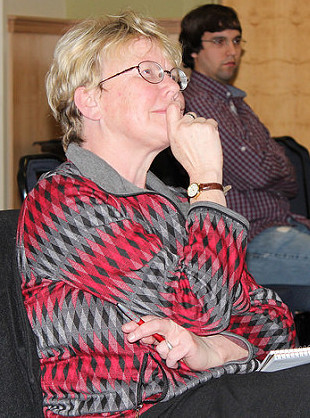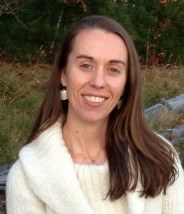Service Learning: Engaging Students for Real-World Problem Solving
Linda Silka gives keynote address at the University of New England Campuses for Environmental Stewardship Best Practice Showcase
By David Sims
When you hear the phrase “student service learning,” you might immediately imagine college kids volunteering time in their community using aspects of their majors—food science, say—spending evenings at a local food pantry serving those gathered for a hot meal to get a better understanding and appreciation of the problem of homelessness and hunger.
It would be a noble gesture to be sure but represents but one version of what the growing trend of service learning for university students, and faculty, entails.
“In addition to volunteering in a food pantry,” notes Mitchell Center Senior Fellow Linda Silka, “we ask faculty and students, ‘Would it be possible to have your learning focused on redesigning the food system so we don’t need food pantries?”’ Silka adds, “Maybe spend some time in a food pantry to see how they operate, but service learning is really about combining what you’re learning in the classroom and in your courses and your major with the kinds of real-world problems that are out there. And, ideally, this kind of effort changes the heart of the coursework as well.”

On September 30 at the University of New England, Silka will give the keynote address to faculty and students gathered for the Campuses for Environmental Stewardship Best Practice Showcase to discuss the successes and challenges of service learning efforts as part of the nationwide Campus Compact.
A coalition of nearly 1,100 colleges and universities committed to the public purposes of higher education, Campus Compact is the only national higher education association dedicated solely to campus-based civic engagement and enables campuses to develop students’ citizenship skills and forge effective community partnerships. Coalition resources support faculty and staff as they pursue community-based teaching and scholarship in the service of positive change.
Says Silka, “Campus Compact is saying, ‘At colleges and universities, what we really need to be doing is finding ways to have our students be more socially engaged using what they’re learning for problem solving. And in looking across the kind of problemscape in our region of New England, the compact has been especially interested in how students from different disciplines and their faculty can think about environmental problems.”
The work of the compact and its members is identifying ways of getting colleges and universities “out there” solving problems rather than just having research end up in journals. According to Silka, in the latest iteration of the compact’s efforts, the focus has been on getting faculty from different disciplines who are all interested in the sustainability and all teaching undergraduate classes “to figure out if there’s a way with a little bit of money they can change their courses so the students aren’t just reading books or listening to lectures but are thinking about on-the-ground problems that exist about sustainability in our region and figure out, in terms of the context of the course, what they can do in terms of projects that make a difference.”
On a related note, Silka points out that the Maine Hunger Dialogue is an active effort by Maine universities and colleges to address the problem of hunger in the state head-on. The 2016 Maine Hunger Dialogue will take place on the University of Maine at August campus October 28-29.
Taking the service learning plunge
In partnership with UMaine associate professor of communication Claire Sullivan and director of sustainability Dan Dixon, among the UMaine/Mitchell Center faculty who have incorporated service learning practices into their coursework are Bridie McGreavy, Sharon Klein, Cindy Isenhour, and Sandra De Urioste-Stone.
McGreavy, assistant professor of environmental communication in the Department of Communication and Journalism and Mitchell Center affiliate faculty member, taught an introductory environmental communication class of over 200 students beginning in 2015— and continuing in the fall 2016 semester—that was funded by Campuses for Environmental Stewardship to incorporate service learning into her class work.
“I wanted to find a way to make this large class more engaging and at the same time we were working together to build service learning into our classes,” McGreavy says. “We did service learning projects around dams as part of our focus on the Mitchell Center-led Future of Dams project.”

Those projects did indeed engage students in hands-on work that took them outside the lecture hall and got their heads out of textbooks. The end result was a collection of student-produced videos, blog posts, and wesbsites focused on how communication shaped the development of the Penobscot River Restoration Project.
“Some of the student video projects were outstanding,” McGreavy notes. “The students are creative and insightful, and because service learning intends to connect with people outside the classroom these are projects I share with colleagues for their own learning and they will be available to the general public as well.”
For Klein, UMaine assistant professor of economics, her service learning project involves a unique energy efficiency program she and some of her students have been involved with and that creates customized window inserts that go inside window frames and provide an extra layer of insulation.
“We did a pilot course in the fall of 2015 with funding help from the Mitchell Center to do this work as a student-run research project,” Klein says. “Ten students, in collaboration with the Rockland-based nonprofit Window Dressers, built window inserts for low-income customers in the Bangor-Orono-Old Town area and then investigated how much energy they saved.”
Klein and students are again doing a window insert build during the fall 2016 semester.
Assistant professor of anthropology Isenhour had students in her course “Natural Resource Management in Cross Cultural Perspectives” engage community partners through observations at forums, interviews, and classroom visits. Many student groups also completed stakeholder values mapping.
And De Urioste-Stone, assistant professor of nature-based tourism, taught a course whereby students developed a regional tourism destination plan for western Maine. The service learning project allowed students to develop critical thinking skills to analyze environmental issues associated with tourism development.
The upcoming UNE conference will bring together faculty and students from New England states affiliated with Campus Compact to talk about the best practices they have learned. Silka’s keynote, she says, will in part be a pep talk for faculty who, through program evaluations, have noted they may not be as motivated to try a second round of service learning teaching “because it’s so hard to do.”
“What I want to point out to them is that almost all of us respond similarly to the first time through – it is difficult to do,” Silka asserts. “It represents a huge change, there’s so much work involved, and there are so many things that aren’t under your control. But by hanging in there and continuing to work on it it really does pay off in the end in terms of better linking research to action and research to teaching. It takes all the different parts of our roles as faculty and can bring them much closer together.”
